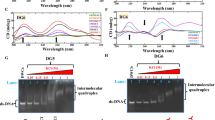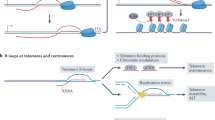Abstract
In certain contexts the DNA triplet GGA, when juxtaposed on opposite strands of a DNA duplex, shows the unusual property of pairing with itself in an antiparallel orientation to form the (GGA)2 motif. In this motif the central guanines do not pair but intercalate and stack between sheared G•A pairs. Similar studies with GCA triplets reveal that they do not form analogous paired (GCA)2 motifs but instead strongly promote formation of a hairpin, the structure of which is now reported here. The GCA hairpin loop consists of a single cytidine residue closed by a sheared G•A pair and this structure is discussed in the context of triplet expansions in triplet-repeat diseases.
This is a preview of subscription content, access via your institution
Access options
Subscribe to this journal
Receive 12 print issues and online access
$189.00 per year
only $15.75 per issue
Buy this article
- Purchase on Springer Link
- Instant access to full article PDF
Prices may be subject to local taxes which are calculated during checkout
Similar content being viewed by others
References
Chou, S.-H., Zhu, L., & Reid, B.R. The unusual structure of the human centromere (GGA)2 motif: unpaired guanosine residues stacked between sheared GA pairs. J. molec. Biol. 244, 259–268, (1994).
Zhu, L., Chou, S.-H. & Reid, B.R. The solution structure of a novel DNA duplex formed by human centromere d(TGGAA) repeats with possible implications for chromosome attachment during mitosis. J. molec. Biol. in the press.
Chou, S.-H., Cheng, J.-W. & Reid, B.R. Solution structure of [d(ATGAGCGAATA)]2 adjacent GA mismatches stabilized by cross-strand base-stacking and BII phosphate groups. J. molec. Biol. 228, 138–155 (1992).
Cheng, J.-W., Chou, S.-H. & Reid, B.R. Base pairing geometry in GA mismatches depends entirely on the neighboring sequence. J. molec. Biol. 228, 1037–1041 (1992).
Li, Y., Zon, G. & Wilson, W.D. NMR and molecular modeling evidence for aGA mismatch base pair in a purine-rich DNA duplex. Proc. natn. Acad. Sci. U.S.A. 88, 26–30 (1991).
Hare, D.R., Wemmer, D.E., Chou, S.-H., Drobny, G. & Reid, B.R. Assignment of the non-exchangeable proton resonances of d(CGCGAATTCGCG)2 using two-dimensional NMR methods. J. molec. Biol. 171, 319–336 (1983).
Zhu, L. & Reid, B.R., An improved NOESY simulation program for partially relaxed spectra: BIRDER. J. magn. Reson. 106, 227–235 (1995).
Chou, S.-H., Cheng, J.-W., Fedoroff, O. & Reid, B.R. The DNA sequence GCGAATGAGC containing the human centromere core sequence GAAT forms a self-complementary duplex with sheared GA pairs in solution. J. molec. Biol. 241, 467–479 (1994).
Poltev, V.I. & Shulyupina, N.V., Simulation of interactions between nucleic acid bases by refined atom-atom potential functions. J. biomol. Struct. Dyn. 3, 739–765 (1986).
Hirao, I. et al. Most compact hairpin-turn structure exerted by a short DNA fragment d(GCGAAGC) in solution; an extraordinarily stable structure resistant to nucleases and heat. Nucleic Acids Res. 22, 576–582 (1994).
Miwa, S. Triplet repeats strike again. Nature Genet. 6, 3–4 (1994).
Willems, P.J., Dynamic mutations hit double figures. Nature Genet. 8, 213–215 (1994).
Mandel, J.-L., Trinucleotide diseases on the rise. Nature Genet. 7, 453–455 (1994).
Wooster, R. et al. Instability of short tandem repeats (microsatellites) in human cancers. Nature Genet. 6, 152–156 (1994).
Richards, R.I. & Sutherland, G.R. Simple repeat DNA is not replicated simply. Nature Genet. 6, 114–116 (1994).
Tautz, D. & Schlotterer, C. Simple sequences. Curr. opin. genet. Dev. 4, 832–837 (1994).
Rubinsztein, D.C. et al. Mutational bias provides a model for the evolution of Huntington's diseases and predicts a general increase in disease prevalence. Nature Genet. 7, 525–530 (1994).
Rubinsztein, D.C., Leggo, J., Amos, W., Barton, D.E. & Ferguson-Smith, M.A. Myotonic dystrophy CTG repeats and the associated insertion/deletion polymorphism in human and primate populations, Human molec. Genet. 3, 2031–2035 (1994).
Brook, J.D., Retreat of the triplet repeat? Nature Genet. 3, 279–281 (1993).
Plateau, P. & Gueron, M. Exchangeable proton NMR without base-line distortion, using new strong-pulse sequences. J. Am. Chem. Soc. 104, 7310–7311 (1982).
Author information
Authors and Affiliations
Rights and permissions
About this article
Cite this article
Zhu, L., Chou, SH., Xu, J. et al. Structure of a single-cytidine hairpin loop formed by the DNA triplet GCA. Nat Struct Mol Biol 2, 1012–1017 (1995). https://doi.org/10.1038/nsb1195-1012
Received:
Accepted:
Issue Date:
DOI: https://doi.org/10.1038/nsb1195-1012



